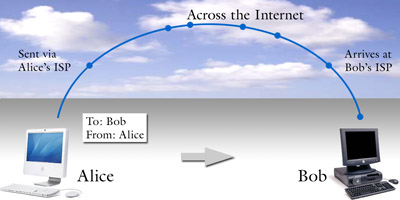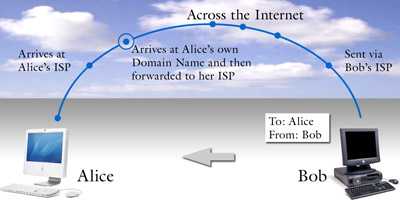Email Forwarding
An Internet Service Provider (ISP) will usually provide email services with your connection to the Internet. To send an email your computer connects to their outgoing mail server (via SMTP) and your message is then relayed across the Internet to the recipient’s mailbox. When the recipient collects email from their mailbox (via POP3) the email you sent is downloaded to their computer. Mobile devices connect via IMAP.
The email address that an Internet Service Provider gives out to customers will usually be in the format of username@ispdomain.com. You could even be issued with something like tr37xwqp@server27.example.com. Although such an address may work perfectly well it is not very practical to give out to other people.
When you register your own domain name it does not matter which email address your service provider gives you. An email that has been sent to you@yourdomain.com will be received by our mailserver and automatically forwarded to you at username@ispdomain.com. As far as the sender is concerned they will only know about the address using your domain name and you can still collect the email from the mailbox provided by your service provider.
However when you send an email it includes the details of your email address. If you update your email software settings so that your sender and reply address is you@yourdomain.com then the people you contact will remain unaware of who your Internet Service Provider is.
From Alice to Bob

From Bob, back to Alice

The benefits of email forwarding
- your ISP email address is unaffected
- continue to receive email in your ISP mailbox
- continue to send email using your ISP mailserver
- collect your email from just one mailbox
- works with as many domain names as you want
- choose your own usernames
- forward additional usernames to other service providers
- change service provider without changing your email address
- fault tolerant - redirect your email via another ISP if necessary
Webmail vs POP mailbox
Email forwarding works with webmail services such as Hotmail, Yahoo! and Google Mail in the same way as it does with a POP mailbox. The only difference is that with webmail you do not download the message to your computer.
The sender and reply address
The majority of Internet Service Providers will allow you to update your email software settings so that your sender and reply address is you@yourdomain.com. However, some ISPs have configured their outgoing mailserver to reject emails if the sender address doesn’t match their domain name. This may help to reduce abuse of their mailserver by spammers but it also means they get a lot of free marketing when you promote their domain name in your email address.
BT customers can apply to clickmigration@btconnect.com and ask for your domain name to be approved on outgoing email. This is a free service. You do not need to pay for an Internet Business Pack or move your domain to their servers.
AOL customers are unable to change their outgoing email address to anything other than username@aol.com. In May 2006 they announced a beta project called MYeAddress which offered the opportunity to use your own domain name. The project closed a few months later and all test accounts were cancelled.
If you find your Internet Service Provider is either unwilling or unable to help you use your own domain name for your outgoing email address we can provide you with a special account. You can continue to use your service provider for your Internet connection.
Google Mail (Gmail) offers webmail access as standard. It can be personalised to use your domain name as the sender and reply address. You can also use the account as a POP mailbox but their outgoing SMTP service is now only available with paid services.
